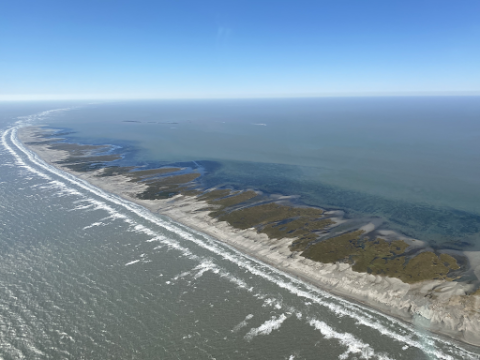The Louisiana and Open Ocean Deepwater Horizon Trustees have released their Draft Joint Restoration Plan and Environmental Assessment #1: Restoring Wetlands, Coastal, and Nearshore Habitats, Federally Managed Lands, Fish and Water Column Invertebrates, Sea Turtles, Submerged Aquatic Vegetation, and Birds of the Chandeleur Islands (PDF, 104 pages) for public review and comment.
The draft restoration plan evaluates projects for partially restoring natural resources injured by the Deepwater Horizon oil spill. The draft plan analyzes alternatives for ecosystem restoration at the Chandeleur Islands: four design alternatives for island expansion and two projects for restoring fish and water column invertebrates.
The island expansion design alternatives are composed of various restoration features, such as beach and dune habitat, constructed marsh, sand reservoirs, pocket marshes, and feeder beaches. One design was identified as preferred, as it will provide the greatest sustained gains in beach/dune and marsh habitat acreage and therefore ecosystem restoration over the other alternatives. It is also the most cost-effective and has the highest likelihood of success.
The alternatives to restore fish and invertebrates propose activities to enhance ecosystem benefits to fishery resources that can be realized by restoring the Chandeleur Islands. The preferred alternative would develop and implement a Chandeleur Islands fisheries engagement and restoration plan to provide tools and information to local fishing communities that help improve the health of fish populations and their habitat. The total estimated cost to implement the two preferred alternatives is approximately $360 million. The TIGs are proposing to allocate approximately $247 million in DWH NRDA funds from various restoration type allocations to implement the preferred alternatives, and the State of Louisiana is actively pursuing additional funding sources for the remainder of the estimated cost.
The Louisiana and Open Ocean Trustees are seeking public comment on the draft restoration plan through July 16, 2025.
Hard copies of the executive summary and fact sheets are also available for review during the public comment period at local public libraries (PDF, 2 pages).
Comments can be submitted during the public comment period by one of the following methods:
- Online: https://parkplanning.nps.gov/LAOOTIGRP1
- U.S. Mail: Coastal Protection and Restoration Authority, 150 Terrace Ave., Baton Rouge, LA 70802. To be considered, mailed comments must be postmarked on or before July 16, 2025.
- Public webinar:
We will hold a public webinar on June 26, 2025 at 11:00 AM CT. We will present the draft plan and take verbal comments during the webinar. Register for the webinar at: https://attendee.gotowebinar.com/register/7003949989564105821
After registering for a webinar, participants will receive a confirmation email with instructions for joining the webinar. Instructions for commenting will be provided during the webinar. Presentation material and factsheets about the projects can be found below.
Draft Plan, Fact Sheets, and Other Documents
- Draft Joint Restoration Plan #1 and Environmental Assessment (PDF, 104 pages)
- Draft Joint Restoration Plan #1 and Environmental Assessment Appendices (PDF, 949 pages)
- Executive Summary (PDF, 4 pages); Translated into Spanish (PDF, 4 pages); Translated into Vietnamese (PDF, 4 pages)
- List of Repositories (PDF, 2 pages)
Factsheets
- Overview Factsheet for Joint Restoration Plan #1 (PDF, 4 pages); Translated into Spanish (PDF, 4 pages); Translated into Vietnamese (PDF, 4 pages)
Get future updates delivered directly to your inbox. Subscribe today for Gulf Spill Restoration news and updates.


